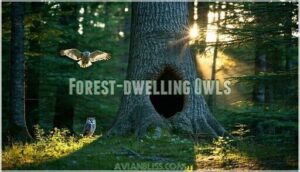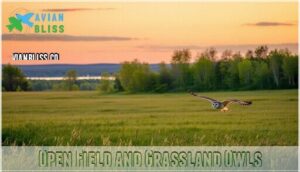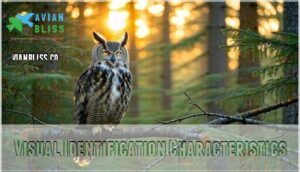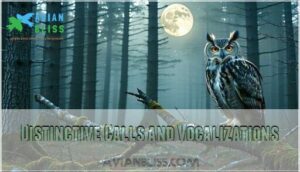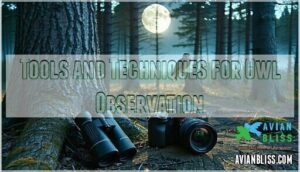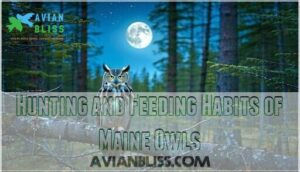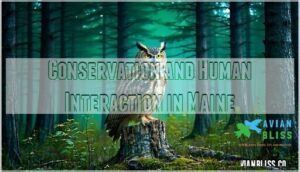This site is supported by our readers. We may earn a commission, at no cost to you, if you purchase through links.

You might spot a Great Horned Owl with its iconic ear tufts or hear a Barred Owl’s “who-cooks-for-you” from the woods.
Even tiny Northern Saw-whet Owls show up, looking adorable but skilled at silent hunting.
Snowy Owls sometimes sweep in for winter, dazzling along the coast.
Each species adapts with its own style, from camouflage to night hunting, and with sharp senses and quirky calls, these birds bring mystery to Maine’s wild side—just wait until you learn who’s really hooting after dark.
Table Of Contents
- Key Takeaways
- Common Owl Species Found in Maine
- Owl Habitats and Distribution Across Maine
- Identifying Maine Owls by Sight and Sound
- Hunting and Feeding Habits of Maine Owls
- Conservation and Human Interaction in Maine
- Frequently Asked Questions (FAQs)
- What owl goes hoo hoo hoo sound?
- What are the most common owls in Maine?
- Is it good to have an owl in your yard?
- What kind of owl hoots during the day?
- Do owls come out during the day?
- How do Maines owls adapt to urban environments?
- What traditional folklore exists about owls in Maine?
- How does light pollution affect owl behavior in Maine?
- Are there any owl rehabilitation centers in Maine?
- How do Maines owls respond to climate change?
- Conclusion
Key Takeaways
- You’ll spot a wide variety of owls in Maine, from Great Horned to elusive Snowy Owls, each with unique calls and clever hunting skills.
- Maine’s owls adapt to habitats ranging from deep forests to city parks, often blending in or hunting at night with silent precision.
- If you want to help, build owl-friendly gardens and install nest boxes, making your yard safer for these natural rodent controllers.
- Owls face threats from habitat loss and climate change, so supporting local conservation, reporting sightings, and learning about their habits makes a real difference.
Common Owl Species Found in Maine
You’ll find Maine is home to a surprising assortment of owl species, each with its own habits and charms.
From the widespread Great Horned Owl to the elusive winter visitor Snowy Owl, these remarkable birds show up in woods, fields, and even city parks.
Great Horned Owl
Anyone hoping to spot a true heavyweight in Maine birdwatching should learn about the Great Horned Owl.
Meet the heavyweight champion of Maine’s woods—the Great Horned Owl stands out on any birdwatcher’s list
Those famous ear-tufts? They help this raptor of Maine blend in and show off during territory defense.
With sharp low-light vision and adaptable nesting habits, this owl species thrives.
Their diet variations even include skunks—talk about a well-rounded Maine owl!
Barred Owl
While the Great Horned Owl rules the treetops, the Barred Owl is busy haunting forest edges and wet woods.
Barred Owl Habitat often includes swamps and old forests. You’ll spot these “who-cooks-for-you” callers year-round in Maine.
Barred Owl Diet focuses on small mammals. Maine also hosts the Black-capped Chickadee as its state bird.
Their calm, watchful Barred Owl Behavior adds a bit of magic to Maine birdwatching.
Eastern Screech-Owl
Urban survivor—the Eastern Screech-Owl brings color and variety to Maine owls.
Its small, stocky shape and range of color morphs help with owl identification. You’ll find both red and gray Screech-Owl Morphologies tucked away in tree cavities.
Eastern Screech-Owl Diet features rodents and insects.
Adaptable nesting habits and urban adaptation set this owl species Maine apart in owl habitat Maine, with its ability to thrive in urban environments and adaptable nesting habits.
Northern Saw-whet Owl
While the Eastern Screech-Owl tends to hide in plain sight, the Northern Saw-whet Owl takes secretive behavior to a new level.
You’ll need patience to spot these small nocturnal birds in Maine.
Look for:
- Plumage camouflage
- Owl size (about robin-sized)
- Crisp white eyebrows
- Population monitoring challenges
- Unique nesting habits
This owl species complements Maine’s rich owl habitat.
Snowy Owl (Winter Visitor)
Switching from the petite Northern Saw-whet Owl, you’ll spot the Snowy Owl—Maine’s cold-weather superstar.
With roots in the Arctic Tundra, these bright white birds sweep in during irruptive years.
Coastal sightings surge, a reminder of winter ecology in action.
Their presence is a signal: climate impacts ripple far.
Here’s a quick snapshot:
| Feature | Details |
|---|---|
| Origin | Arctic Tundra |
| Season in Maine | Winter |
| Main Habitat | Coastal areas |
| Peak Years | Irruptive years |
| Sightings Keyword | snowy owl Maine |
Unique and Rare Owl Species
As winter Snowy Owls catch your eye, don’t overlook Maine’s rare guests: the Great Gray Owl, Boreal Owl, and Northern Hawk Owl.
Each species pops up in scattered habitats.
Population status? Uncertain, sometimes hanging by a feather.
Watch—and listen—when the woods get quiet, and you might also spot the elusive Long-eared Owl and a rare Barn Owl.
Owl Habitats and Distribution Across Maine
You’ll notice owls can settle just about anywhere in Maine, from deep forests to grassy fields or towns where you least expect them.
Whether you’re hiking, driving, or simply looking out your window, you’ve got a good chance of spotting them in wild or surprising places year-round, which makes year-round viewing a unique experience.
Forest-dwelling Owls
In the deep forests of Maine, you’ll spot the Great Horned Owl, Northern Saw-Whet Owl, Barred Owl, and even the elusive Boreal Owl.
These birds rely on Forest Habitats for Nesting Habits, using expert Camouflage Techniques.
Listen for classic barred owl Maine calls.
Forest Conservation keeps these woods and Owl Sounds wild and alive for everyone to enjoy.
Open Field and Grassland Owls
Strolling through Maine’s grasslands, you might spot a Short-eared Owl gliding low, hunting by daylight.
These farmland owls love open fields rich with prey abundance, but habitat loss puts them at risk.
Snowy Owls and Northern Hawk Owls join them in winter, drawn to similar habitats.
Conservation efforts aim to keep these grassland species thriving—one field at a time.
Coastal and Island Owl Populations
Open fields and grasslands aren’t the only owl hotspots—coastal Maine and its islands attract some unique owl species in Maine.
Salt-air Island Habitats play host to Great Horned and Northern Saw-whet Owls, while Coastal Migrations bring in wild Snowy Owl irruptions.
The presence of these owls is influenced by coastal bird adaptations.
Watch for:
- Sea Bird Interactions
- Tidal Zone Foraging
- Nesting on rocky cliffs
- Maine bird species diversity
Urban and Suburban Owl Adaptations
You’ll sometimes spot Urban Owls roosting quietly in city parks, sneaky as ninjas in the night.
Suburban Habitats offer easy meals—think city prey like mice and small birds.
Help these masters of owl adaptation by setting up Owl Boxes in backyards.
Maine birdwatching locations reveal how owl habitats in Maine are changing with urban environments and growing owl conservation in Maine.
Identifying Maine Owls by Sight and Sound
You’ll spot Maine’s owls by their size, colors, and those haunting calls at night.
Don’t be surprised if you recognize a hoot before you see a feather—your ears often lead the way.
Visual Identification Characteristics
Spotting owls in Maine starts with sharp eyes and a knack for details.
Look for Plumage Patterns and those signature ear tufts—like the great horned owl’s tall “horns.”
Watch for distinct Eye Colors and unique Beak Shapes.
Feather Textures set each species apart; notice the barred owl’s dark stripes or a northern sawwhet owl’s mottled fluff for smart owl species identification.
Distinctive Calls and Vocalizations
You’ll notice owl vocalizations range from deep, rumbling hoots to sharp screeches and odd whistles.
Pay close attention—each species delivers its own unique sound waves and bird songs after dark.
Whether it’s the Great Horned’s classic “hoo-hoo,” or the Barred Owl’s “who cooks for you,” call variations help with owl species identification among Maine’s nocturnal birds, using unique sound waves.
Tools and Techniques for Owl Observation
If you’re keen to unravel Maine’s owl mysteries, you’ll want Owl Binoculars with Night Vision for low-light owl watching.
Bring Camera Traps and audio recorders to catch elusive owl calls at favorite birdwatching locations.
Field Guides are handy for on-the-spot owl observation and identifying species in varied owl habitats—each tool reveals a piece of the wild puzzle.
For ideal viewing, consider planning your trips during moonlit nights to increase your chances of spotting owls in their natural habitat with the help of Night Vision.
Tracking Owl Activity and Behavior
If you want to track owl behavior in Maine, follow the signs—listen for calls at dusk, check likely roosting sites, and scan for pellets under pines.
Keep notes on nocturnal birds, watch for changes in foraging patterns or nesting habits, and spot shifts in owl migration.
These simple steps reveal the secret lives of Maine owl species.
Hunting and Feeding Habits of Maine Owls
You’ll find that Maine owls use clever hunting tactics, from silent flights at night to surprising daytime hunts.
By studying what they eat and how they hunt, you’ll gain a clearer picture of how these fascinating birds survive all year round.
Nocturnal Vs. Diurnal Hunting Patterns
Hearing an owl’s call at dusk can spark curiosity—why are some active at night, others by day?
Maine’s nocturnal birds exhibit distinct owl behavior through:
- Nocturnal hunting peaks, using silent flight and shadow camouflage.
- Diurnal behavior, especially Snowy Owls in winter sun.
- Owl habitat and range shape hunting times.
- Moonlight effects boost activity.
- Nocturnal predators thrive on darkness.
The combination of these factors contributes to the unique characteristics of Maine’s owl population, with silent flight being a key adaptation for their nocturnal lifestyle.
Prey Preferences by Species
After dark, Maine’s owls get busy.
Rodent prey leads the menu for Great Horned Owls, while Barred Owls switch gears to frogs and small mammals.
Snowy Owls go for birds and the fish diet, especially in winter.
If you’re curious about owl diet and prey, check out the comparison below—each species has its tastes.
| Species | Main Prey | Notable Hunt |
|---|---|---|
| Great Horned Owl | Rodents, birds | Small mammals, skunks |
| Barred Owl | Frogs, rodents | Bird consumption |
| Snowy Owl | Birds, fish diet | Insect hunting |
Hunting Techniques and Adaptations
By night, Maine’s nocturnal birds reveal their clever side.
Thanks to keen hearing, they pinpoint rodents hidden under snow. Their silent flight, a masterclass in stealth, lets them swoop without a sound.
Strong talon structure means any prey ambush is quick. Most owls use a sit-and-wait approach, showing that patient owl hunting always pays off.
Seasonal Variations in Hunting Behavior
Seasons in Maine bring a twist to owl hunting patterns.
In winter, snowy fields lure nocturnal birds like Snowy Owls to hunt during the day—chasing what prey braves the cold.
In warmer months, Barred Owls and Great Horned Owls shift their owl behavior patterns, tracking rodents or frogs.
Each season, adaptive behavior shapes owl diet and prey selection.
Understanding effective hunting gear systems is essential for studying these patterns.
What’s in an Owl Pellet?
If you’ve ever cracked open owl pellets, you’re diving into nature’s time capsule.
You’ll find tiny bones, fur, insect shells, or even bird feathers—the leftovers from entire prey the owl couldn’t digest.
This Pellet Composition offers a window into the owl diet.
Owl regurgitation is tidy: no mess, just science! Bone Analysis and Feather Identification help reveal what’s on the menu.
Conservation and Human Interaction in Maine
You play a pivotal role in protecting Maine’s owls, from reporting sightings to supporting safe habitats.
Watch out for these birds near roads and share your curiosity—your actions help keep their mysterious calls echoing through Maine’s forests.
Population Trends and Threats
Switching gears from owl diets, let’s face Maine’s owl population trends head-on.
Habitat loss, climate change, and human impact create real challenges. Some species face population decline, while more adaptable owls spread out.
Conservation efforts matter; they help protect owl species diversity in Maine. Keeping an eye on Maine owl conservation is key, especially for future Maine wildlife.
Understanding owl species habits is essential for effective conservation strategies and to ensure the well-being of Maine’s wildlife.
Rehabilitation and Research Efforts
After exploring population threats, you might wonder what happens when an owl ends up in trouble.
That’s where Wildlife Rehab kicks in. Owl Rescue teams and centers across Maine—like Saco River and Avian Haven—lead the way in injury treatment, field research methods, and rehab.
These wildlife rehabilitation facilities feed Conservation Science and owl research projects, supporting owl conservation Maine and Maine Audubon.
The use of proper Owl Rescue Kits is essential for the successful rehabilitation of injured owls.
Public Education and Ecotourism
Joining an owl tourism outing or attending an education program through Maine Audubon opens your eyes, not just to birdwatching in Maine, but to a deeper sense of freedom and wonder.
Community outreach and ecotourism benefits go hand-in-hand, inspiring everyone to protect wildlife. That’s how owl conservation in Maine grows—through real-world learning, shared stories, and dedicated owl watching.
By supporting responsible tourism practices, individuals can contribute to the conservation of owl habitats and the protection of these magnificent birds.
Owl Protection Laws and Regulations
After learning about outreach and owl ecotourism, it’s smart to know your rights and rules.
All native owls in Maine have federal protection under the Migratory Bird Treaty Act.
Hunting laws ban trapping or harming them.
Permit requirements from the US Fish and Wildlife Service cover research, rehab, or lethal control.
Wildlife regulations drive ongoing conservation efforts and strict enforcement, which is crucial for the protection of native owls, ensuring their safety under the law, and this is a result of strict enforcement.
Safety and Attracting Owls to Your Property
Building Owl Friendly Gardens takes a bit of know-how and patience.
Patience and a little care turn any garden into a secret haven for Maine’s wild owls
Keep your property safe by turning off bright lights and using window decals to reduce bird collisions.
Install sturdy owl nest boxes away from busy paths.
Plant native trees and shrubs—these attract owls while offering natural cover.
Preventing conflicts means supporting natural owl habitats and boosting local wildlife conservation efforts, right in your backyard.
Using proper nest box designs can substantially enhance the effectiveness of your owl-friendly garden, by creating a safe environment for owl habitats and promoting local biodiversity.
Frequently Asked Questions (FAQs)
What owl goes hoo hoo hoo sound?
You’ll recognize the Great Horned Owl by its classic "hoo-hoo-hoo" call.
This large, widespread owl produces deep, resonant hoots that carry far through the night, making it Maine’s most recognizable owl voice.
What are the most common owls in Maine?
Over 9,000 Maine students learn about owls every year.
You’ll most likely spot Barred Owls, Great Horned Owls, and Northern Saw-whet Owls—think of them as the state’s feathery night-shift.
Watch for big eyes and hoots!
Is it good to have an owl in your yard?
Having an owl in your yard is like nature’s own pest control—small rodents beware!
Their presence means a healthy ecosystem, but give them space.
Don’t disturb nests, and enjoy their quiet company from a distance.
What kind of owl hoots during the day?
If you hear hooting when the sun’s high, you’ve probably spotted a Barred Owl.
Unlike most owls, they’ll call out “**Who cooks for you?
**” even in daylight—kind of like the neighborhood barista that never clocks out.
Do owls come out during the day?
Like a shadow slipping through daylight, you might just spot certain owls hunting or flying on cloudy afternoons or dusk.
Most are night lovers, but species like Short-Eared Owls do break the rules on occasion.
How do Maines owls adapt to urban environments?
You’ll spot them hunting under streetlights, nesting in cavities, and staying quiet to dodge traffic.
These birds follow the food—think mice near dumpsters. Quick to adjust, they thrive on your leftovers and city squirrels.
What traditional folklore exists about owls in Maine?
When the night calls, wisdom listens.
You’ll hear tales of owls as messengers or guardians—some say their hoots warn of change.
Others believe an owl’s visit is good fortune, a sign of nature’s watchful spirit.
How does light pollution affect owl behavior in Maine?
Too much artificial light at night can mess with an owl’s hunting and nesting habits.
You might see owls less often, as they’ll avoid well-lit areas, throwing the local food chain for a loop.
Are there any owl rehabilitation centers in Maine?
Ironically, you don’t need a magic wand to help injured owls—rehabilitation centers operate in Maine.
Wildlife clinics and organizations, like Avian Haven and Center for Wildlife, treat and release owls hurt by cars or windows.
How do Maines owls respond to climate change?
As seasons shift and winters warm, you’ll find owls shifting nest dates or hunting patterns.
Some, like Snowy Owls, wander farther to find food.
Their survival’s a balancing act, like walking a tightrope in the wind.
Conclusion
Picture yourself beneath Maine’s vast night sky, listening for a distant call or catching a glimpse of silent wings.
By observing owls in Maine, you’ll uncover each species’ unique habits, from clever hunting tricks to their fascinating calls.
Armed with a bit of patience and curiosity, you can safely spot, identify, and even help protect these remarkable birds.
Stay alert—you never know when those “masters of stealth” will make your next hike a wild adventure.

